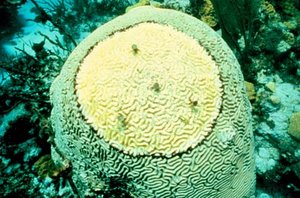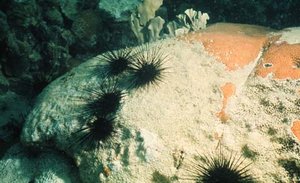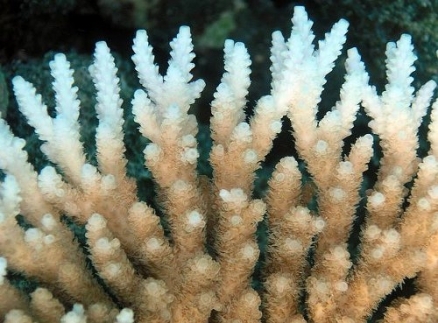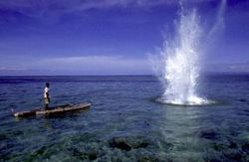Threats to coral reefs
Contents
Introduction
Threats to coral reefs occur from a number of sources; however, the chief destruction mechanisms arise from direct human or anthropogenic contact events such as ship grounding, coral mining and nutrient runoff from land pollution or sewage. It is estimated that ten percent of all coral reefs are already degraded beyond repair, with thirty percent estimated to be in critical condition and at risk of destruction within ten to twenty years. If current pressures continue then a total of sixty percent of the world’s coral reefs may be severely damaged by 2050. The damage/degradation is due to both natural events and anthropogenic effects, but direct human contact by coral mining, ship damage, dredging, water pollution surface runoff, and souvenir collection are contributing the majority of damage (Kimura et al, 2004) (Arrivillaga, A. & M. A. Garcia, 2004) (Lovell et al., 2004); overfishing and dynamite fishing are other major causes of reef damage.
Natural Events
 Sri Lankan reefs damaged by a tsunami. (Source: National Aquatic Resources Research and Development Agency)
Sri Lankan reefs damaged by a tsunami. (Source: National Aquatic Resources Research and Development Agency) Storms
Coral reefs can be damaged by natural events such as hurricanes, cyclones, and tsunamis. Wave activity can break apart corals; branching corals are more susceptible to storm damage than mound-building corals. Storms rarely kill all corals, and because storms are a natural part of coral reef ecosystems, coral species are generally adapted to this type of disturbance and be able to recover following storms. However, human alteration to the environment may make recovery more difficult. For example, the addition of nutrients or removal of herbivores might favor the growth of algae that is able to overgrow coral before they are able to recover.
Temperature Changes
Coral reefs require particular environmental conditions for growth and water (Seawater) temperatures from 23–29 °C are optimal for growth. Increasing temperature too much can cause the coral polyps to expel the zooxanthellae and lead to coral bleaching where the zooxanthellae are expelled from the coral by the polyps. The El Niño Southern Oscilation (ENSO) event of 1997-1998 caused servere coral bleaching in the Indo-Pacific with 70-80% of shallow-water corals killed in some regions.
Coral Diseases
 Black Band Disease. (Source: USGS)
Black Band Disease. (Source: USGS) Over the last thirty years scientists have identified about 30 diseases of corals. The causes and effects of coral disease are still poorly understood. Coral diseases can be caused by bacteria, fungi, algae and worms. Coral disease has had a major impact on Caribbean reefs, where 80% of coral has been lost to disease in the last twenty years. Only about seven diseases have been recorded from corals on the Great Barrier Reef, and disease is not considered a major threat to that Reef.
The frequency of coral diseases appears to have increased significantly over the last ten years, causing widespread mortality among reef-building corals. This increase may be related to deteriorating water quality associated with anthropogenic water pollutants and increased sea surface temperatures which may allow for the proliferation and colonization of disease-causing microbes. Thus the effect of coral diseases may have been made worse by human activity.
Anthropogenic Effects
Water Pollution
Coral reefs can be damaged by a variety of water pollutants that are produced by a number of anthropogenic sources. Agricultural runoff can contain herbicides, pesticides, and nutrient fertilizers. Nitrogen and phosphorus addition can fertilize algae and result in algal blooms. Because algae can potentially grow much faster than coral, they can out-compete corals. For example, in China, river discharges carrying nutrient runoff to Yulin Bay and Sanya Bay caused significant damage to the receiving coral reefs compared to Yalong Bay which gets little runoff and coral reefs are healthy.(Kimura, 2008)
Human sewage, often untreated, can add nutrients, microorganisms, and other pollutants to coral reefs; moreover, nutrients in sewage can cause eutrophication. Bacteria added by sewage pollution are suspected causes of increased incidences of coral diseases such as white band disease. For example, urban sewage discharged largely untreated into Daya Bay has resulted in the loss of coral communities.(Kimura et al, 2004)
Chemical pollution can also harm coral reefs. For example, oil spills, the result of spills from drilling or discharge of oil from vessels can harm reefs. They can be especially harmful if they occur during coral spawning because the oil can kill eggs and sperm.
Solid pollution such as plastics and discarded fishing nets (ghost nets) can also damage reefs.
Sedimentation
Human activities on land such as the clearing (Deforestation) of forests, slash and burn agriculture, road building, and other development can lead to increased rates of sedimentation. High sediment load can reduce light penetration and reduce the photosynthetic activity of zooxanthellae. The problem of sedimentation of coral reefs has been increased by the removal of mangrove and seagrass communities that naturally filter out sediments.
Destructive Fishing Practices
Many fishing practices harm the reef by physically damaging the reef or by killing non-targeted reef fish or other reef organisms. Blast fishing, a method of fishing in pars of the Caribbean, East Africa, and Southeast Asia, uses underwater explosions to damage the swim bladders of fish so that they float to the surface where they are easily captured. The blast of the explosions destroys coral and flattens the reef structure. In parts of China fishermen use cyanide to stun fish so that they can be captured alive; another Chinese practise, a style of fishing called muro-ami involves scaring into a net fish by pounding on the reef with heavy objects that severely damage the coral reef.(Kimura et al, 2004)
overfishing has badly damaged coral communities around Hong Kong and China's Xisha islands, causing most high-value fish species to become locally extinct.
Traps and monofilament nets also snag corals and cause damage to them when retrieved. Abandoned nets can smother corals. Other threats include bomb fishing, which has occurred in the South China Sea for more than 100 years, and recently there has been the use of cyanide to catch fish. Illegal fishing and the sale of living corals for the aquarium trade are problems around Hainan Island. Bomb fishing has been widely practiced in Hainan Island and the remote Nansha Islands, which has resulted in 50-80% coral mortality. Cyanide fishing by large-scale commercial operators and for collecting aquarium species occurs in the remote Xisha and Nansha islands.
Unsustainable Fishing
In 1950 no fisheries were reported as being overexploited whereas by 1996 35% of fisheries were reporting overexploitation and an additional 25% were reported as being near overexploited. Overfishing can have a variety of negative effects on the environment. Overfishing can reduce genetic variation in a population making it harder for species to adapt to environmental change and mate. In addition, overfishing can alter trophic interactions and cause unexpected indirect effects on the environment. For example, in areas where predators have been removed increases in population size of their prey have resulted in unintended effect on the environment.
Coral Reef Human Exploitation and Contact
In some locations direct human contact is the major cause for reef decline. This activity may include impact from scuba divers, specimen collection or damage by boating vessels. In the case of the Great Barrier Reef in Australia, Daley has conducted extensive documentation illustrating that besides overfishing, a major degradation impact to the coral reefs has occurred due to collection of reef specimens, which activity was especially intense in the 20th century,. but continues until present time (e.g. early 21st century. (Daley, 2014) Such removal of corals has taken place both legally and illegally; in fact since "No Take" zones have been expanded by the Queensland authorities, there has been measurable improvement in coral health. Considerable amounts of coral removal have been done overtly as commercial gathering for specimen sale.
In Fiji, major commercial exploitation is ongoing, with over 800,000 kilograms of coral being harvested and exported for aquarium use. The economic pressure for this trade is immense with the average harvest employee making more than the average wage per Fiji resident. (Lovell et al., 2004)
In the Hainan Island area of China, 95 percent of coral reefs have been destroyed by commercial mining of corals for construction materials and souvenirs; moreover, in the South China Sea, reefs and atolls have been paved for military installations and armaments. Most of these islands belong to nations other than China.(KImura et al, 2008) In Belize, major reef loss has occurred by marine sand mining used for coastal fill. (Arrivillaga, A. & M. A. Garcia, 2004)
Global Change
Ocean Temperature Change and Coral Bleaching
Any increases in ocean temperatures could increase the rate and extent of coral bleaching. Rates of coral bleaching have increased since 1979.
Increased Atmospheric Acid Content
The amount of atmospheric sulfur dioxide and oxides of nitrogen has increased since the beginning of the Industrial Revolution. The chief sources of these strong acids is unscrubbed power and industrial burning of coal in China, India and Brazil. Carbon dioxide in the air has also increased by over one-third over the last 50 years due to the burning of fossil fuels and deforestation. Increasing the amount of atmospheric acidic gas that dissolves into the water (Seawater) lowers pH and appears to be dissolving the skeletons of some corals. Thus, corals may form weaker skeletons, making them more susceptible to damage from storms and high wave action.
Indirect Ecological Effects
A species may affect another species directly by eating them or by serving as food. In addition, species may affect each other indirectly. For example, removing a predator might harm the competitor of a prey species because fewer predators results in a larger population size of its prey which can in turn decrease the population size of its competitor.
Loss of Herbivores
 Long spined urchins (Diadema antillarum) grazing. (Source: USGS)
Long spined urchins (Diadema antillarum) grazing. (Source: USGS) Because of their much higher growth rates, algae should be superior competitors to corals. Thus, the presence of herbivores should be very important in allowing corals to exist. The importance of herbivory in allowing the co-existence of coral and algal species has been well demonstrated by examining what happens when herbivores are removed.
In 1983-1984 populations of the long-spined urchin (Diadema antillarum) were decimated by the attack of some unknown pathogen. The sequence of infection suggested that the mortality was caused by a pathogen that entered the Caribbean through the Panama Canal. Mortality was so severed that in some locations populations decreased to less than 2% of their normal size. Over twenty years later, [[population]s] have still not recovered in some parts of the Caribbean. The fact that algal cover increased and coral cover decreased when the Diadema were removed and that algal cover has decreased and coral cover has increased in areas where Diameda has recovered suggests that herbivory by the urchin allows coexistence between the algae and corals.
Herbivore populations may also be reduced by overfishing. For example, in Jamaica, high population pressures have led to the overfishing of herbivorous fishes which has caused the cover of corals to decrease from 50-60% in the 1970s to less than 10% today.
References
- Arrivillaga, A. and M. A. Garcia , 2004 , Status Of Coral Reefs Of The Mesoamerican Barrier Reef Systems Project Region, And Reefs Of El Salvador, Nicaragua And The Pacific Coasts Of Mesoamerica. . p: 473-492. in C. Wilkinson (ed.). Status of coral reefs of the world: 2004. Volume 2. Australian Institute of Marine Science, Townsville, Queensland, Australia. 557 p
- Birkeland, C. (ed.), Life and Death of Coral Reefs, Chapman and Hall, New York, xviii + 536 pp. (1997).
- Daley, Ben. Great Barrier Reef: An Environmental History, Routledge Publishers. (2014)
- Darwin, C., The Structure and Distribution of Coral Reefs, Smith, Elder and Co., London, (1842)
- Dubinsky, Z. (ed.), Coral Reefs: Ecosystems of the World Vol. 25, Elsevier Science, 550 pp. (1990)
- Hopley, D., S. Smithers, and K. Parnell. The Geomorphology of the Great Barrier Reef: Development, Diversity, and Change, Cambridge Univ. Press, 505 pp. (to be published in 2007)
- Ricardo Calado, Ike Olivotto, Miquel Planas Oliver (2017) Marine Ornamental Species Aquaculture. John Wiley & Sons
- Kimura, T., C.F. Dai, H-S. Park, H. Hui and P.O. Ang. 2008. Status of Coral Reef Resources in East and North Asia (China, Hong Kong, Taiwan, South Korea and Japan). In: Wilkinson, C. (ed.). Status of Coral Reefs of the World: 2008. Global Coral Reef Monitoring Network and Reef and Rainforest Research Center, Townsville, Australia. p145-158.
- Lovell, E., H. Sykes, M. Deiye, L. Wantiez, C. Garrigue, S. Virly, J. Samuelu, A. Solofa, T. Poulasi, K. Pakoa, A. Sabetian, D. Afzal, A. Hughes and R. Sulu , 2004 , Status of Coral Reefs in the South West Pacific: Fiji, Nauru, New Caledonia, Samoa, Solomon Islands, Tuvalu and Vanuatu. . p: 337-362 . in C. Wilkinson (ed.). Status of coral reefs of the world: 2004. Volume 2. Australian Institute of Marine Science, Townsville, Queensland, Australia. 557
- Smith, J. E., M. J. Risk, et al. (1997). "Rapid climate change in the North Atlantic during the Younger Dryas recorded by deep-sea corals." Nature 386(6627): 818-820. |}
- Spalding, M.D., C. Ravilious, and E.P. Green, World Atlas of Coral Reefs, UNEP-WCMC, Univ. California Press, 424 pp. (2001)
- Reuben Sulu (2007) Status of Coral Reefs in the Southwest Pacific. IPS Publications, University of South Pacific
- Veron, J.E.N. and M. Stafford Smith, Corals of the World, Australian Inst. Marine Science, Australia, 1350 pp. (3 volumes) (2000)
- Threats to Coral Reefs, CORAL.
- Threats to Coral Reefs, WWF.

